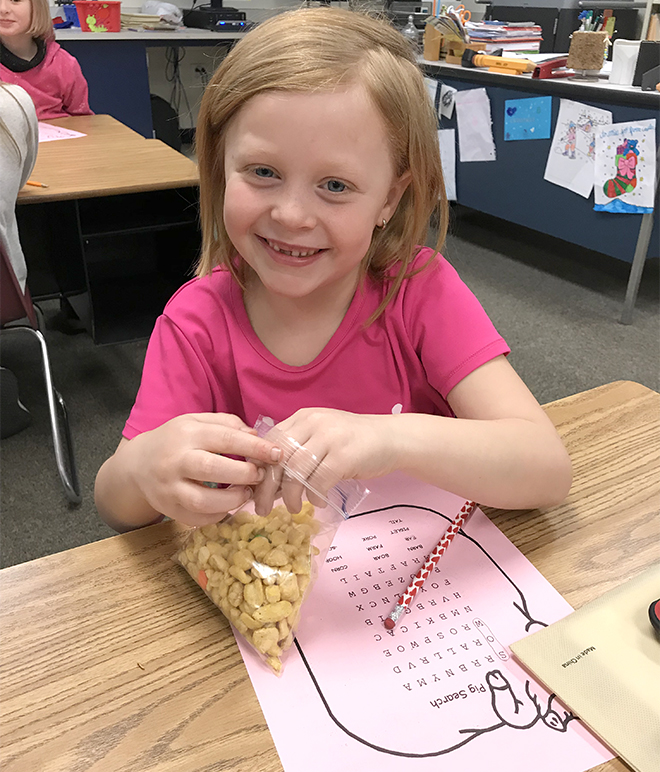Pig Tales: Students learn about swine with Ag in the Classroom

SUBMITTED PHOTO Tempo
Caylen Kirchner, a Forreston 1st grader, enjoys the pig feed sack she made as part of an Ag in the Class-room program through U of I Extension.
First grade students at Forreston learned how and why pigs are raised. A month ago we weren’t talking about a possible shortage of pork products. It’s not because the farms have stopped raising pigs rather a shortage of workers.
It takes a lot of people at the facilities that harvest the livestock and package it for grocery stores and restaurants, Covid19 has made working in a place with large numbers of people problematic. At some locations there are rapidly spreading cases of Covid19, and at other locations workers are just not showing up because they are afraid.
This causes an oversupply of market animals due to plant shutdowns while we may have emptier shelves with no way to make the connection between them. However, farmers are still taking care of animals and crops hoping things return to normal soon. They want to provide consumers with plenty of healthy foods.
Forreston 1st graders did watch a 5-minute DVD called, “The Amazing Pig.” Class discussion involved how hog production has changed over the years. Pigs were known for being dirty animals because they wallowed in the mud. Today, most farmers keep their animals in a building that is temperature controlled so that the pigs don’t get too cold or too hot because pigs can’t sweat.
Farmers used to feed their pigs slop, a mixture of leftovers from the farmhouse. Today, farmers feed their animals a balanced mixture of corn, soybeans, vitamins, and minerals. They also have a constant supply of water available to them.
The students had previously learned about corn so they were reminded of corn and were able to learn more about soybeans. In order to remember the balanced diet that pigs are fed, students made pig feed sacks. Students put food items that represented the pig’s diet into snack size bags.
Their feed sacks included: Corn Pops for corn, roasted edamame for soybeans, sunflower seeds for healthy fats, and M&M’s were vitamins. While waiting their turn to make a feed sack, students completed a pig search, a word search that included terms they had learned such as piglet, boar, and sow.
Students also learned many meat products as well as by-products come from pigs. These by-products are then turned into things we use daily like glue, crayons, buttons, and insulin.
Agriculture in the Classroom is a program to help students gain a greater awareness of the role of agriculture in the economy and society. Students learn that thousands of farm products are in the world around them—on their plate, in the clothes they wear, in the medicine that makes them well, and in earth-friendly fuels and plastics.
Ag in the Classroom is offered through the University of Illinois Extension-Ogle County in partnership with Ogle County Farm Bureau, Carroll County Farm Bureau, Ogle County Soil & Water, and Carroll County Soil & Water. For more information about the program, call the Ogle County Extension Office at 815-732-2191.


